The Panchalinga Darshan is held at Talakad in Karnataka and involves the darshan of five Shivling during an auspicious period as per Hindu Panchang. The Panchalinga Darshana constitutes of darshan of Shivling at Vaidyeshwara, Pataleshwara, Maruleshwara, Mallikarjuneshwara and Arakeshwara temples. It is believed that a darshan of the five Shivlings during the special occasion helps in attaining peace and prosperity. People also undertake the darshan to fulfill their desires.
Panchalinga Darshana is usually held once in 12 years at Talakad and depends on specific astrological calculation. But the 12 year cycle is broken depending on astrological calculation.
During the period of darshan, pilgrims take a holy dip in the Cauvery River (Kaveri) and worship the main deity at Vaidyeshwara temple followed by Arakeshwara, Maraleswara, Pathaleswara and Mallikarjuna temples. All the temples are located in a radius of five miles.
The Vaideshwara Temple, which is the epicenter of Panchalinga Darshan, is completely buried beneath sand dunes during certain period depending on the water level in Kaveri River. The temple comes to life when it is excavated for the Panchalinga Darshan.
Vaidyeshwara, Pataleshwara, Maruleshwara are located at Talakad, Arkeshwara is located at Vijapura, and Mallikarjuna is at Mudukuthore.
Panchalinga darshana is a rare pilgrimage occasion, occuring once in every few years. Tradition has it that pilgrims should first bath in the Gokarna theertham, worship Gokarneswara and Chandikadevi, and then worship Vaidyeshwara, and then bath in the northern eastern southern and western stretches of the Kaveri and then worship Arkeshwara, Pataleshwara, Maraleshwara and Mallikarjuna, returning to Vaidyeshwara after each worship, finally worship Kirtinarayana and conclude the pilgrimage in one day.

The highly religious atmosphere has given rise to mythological connections of Talakad. As narrated in skanda purana, the place got its name from the two kiratas by name Tala and Kada. Somadatta a pious brahmana of kasi prayed to lord Sive for moksha and he was asked to proceed to Talakad or Gajaranyakshetra.
On his way he and his associates were killed and they were reborn as elephants at Siddhogajaranyakshetra. These elephants after their daily bath used to worship a tree with flower and the two kirata brothers Tala and Kada out of curiosity cut this tree only to be astonished to see a Sive linga. They prayed to Lord Sive for mercy and attained Maksha and henceforth the place came to be known as Talakada. Because of the divine elephants the place became sacred as Siddha gajaranyakshetra.
It is not easy to explain the place name Talakadu in a satisfactory manner.
Though it is not possible to understand the meaning of the first part namely Tala,the second part kadu in Kannada means a forest. Hence it was Sanskritised
as Talavanapura or Dalavanapura (Tala+vana+pura). Epigraphs of the early period refer to this place by its Sanskritised form Talavanapura.
Before understanding the history of the place it is desirable to refer to an important religious event with which this place is associated and is also famous for it. This is Panchalinga darsana and lakhs of people throng at this place to have the darsana of five lingas on a day on which strange astronomical combination takes place. This combination is as follows: It should be a new moonday of the month of Kartida and a Monday and the Sun should be in scorpio. This combination occurs at various intervals ranging from four to fourteen years. The last Panchalinga darjana took place on 16-11-2009.
Siva manigested himself in different parts of this place. They are Arkesvara on the bank of uttaravahini:Patalesvara or Vasukisvara on the bank of Purvavahini;
Maralesvaran or Saikatevara on the dakshinavahini Mallikarjunesvara on the Somagiri or Mudukutore on the paschimavahini and Vaidyesvara in the centre. The ritual of Panchalinga darsana involves first taking both in Gokarnatirtha and visiting Vaidyesvara in wet clothes. Then the other four lingas should be worshipped, each time taking fresh bath and reporting it Vaidyesvara each time in the order of Arkesvara, Patalesvara, Maralesvara and Mallikarjunesvara. The entire round by walk covers a distance of about 30 Kms and this has to be finished in one day. The religious fervor of the devotees is such that literally several lakhs of people meticulously follow the above routine and complete the ritual of Panchalinga darsana and earn religious merit.

Talakad becomes a part of the Vijaynagara empire. madhava-mantri who belonged to Talakad itself built an anecut in C. 1342 A.D. which helped the irrigation of nearby lands and became a great boon to the people of Talakad.
Realising the significance of Talakad, the Vijayanagara rulers made it into an important town. The local governor who was stationed at Srirangapattana Was to look after Talakad. Actually Tirumalaraya, also calledSrirangaraya, was the governor,at Srirangapattana in the early part of the seventeenth century. At this point we have to reconstruct the history of Talakad with the help of literary works and a popular folk tale.
Srirangaraya, the governor at Srirangapattana was afflicted with some deadly disease and on hearing the healing powers of God Vaidyesvara at Talakad came to the temple. His wife Srirangamma also referred to as Alamelamma, was kept in charge at Srirangapattana. But the condition of Srirangaraya deteriorated and irangamma came to Talakad to see her husband. The ruling Mysore Wadeyar king Raja Wadeyar came to dnow of this. He also heard of the large amount of precious jewellery brought by Srirangamma. Of them a fine nose ornament caught the fancy of Raja Wadeyar and requested Srirangamma to five it to him.
When the lady refused to part with it, Raja Wadeyar declared a war and reached the other bank at malingi .She crossed over the river and reached the other bank at malingi .Sshe threw all the jewels into folk curse thus:
Talakadu maralagali
Malingi maduvagali
Mysurudoregalige makkalilllade hogali
It means:Let Talakad become sand ; Malingi become a whirlpool and let there be no children to the kings of Mysore . This folk tala thus explains the formation of the sand dunes at Talakad. The date of this event is said to have been 1610 A.D. The significance of this event will be discussed later. Thus, Talakad came to be included in Wadeyar kingdom and it remained with the Wadeyars till the erstwhile Mysore state became a part of the Indian union under the name Karnataka state.
According to this traditional story, formation of sand dunes began to take place in the early part of the seventeenth century A.D. As the river Kaveri takes a sharp bend here during the period of south-west monsoon, particles of sand are carried by the wind with great speed and deposited on the part of the town.
Thus the sand used to advance at the rate of 8 to 10 feet per year. In course of time, the entire town was covered with sand to a height of thirty feet. As and when the sand began to advance, inhabitants lift the village and moved towards north. Thus the ancient town around Kirtinarayana ,Patalesvara, Maralesvara,and Vaidyesvara temles have been covered by the sands. This was the old town during the pre-Vijayanagara period. It seems that during the period of Sir.M.Visweswaraiah, trees were planted in good numbers to prevent the carrying of sands into the town. Perhaps, this was partly successful and the sands have not advanced further. Thus, sand has played an important role in the liter history of Talakad.
Arkeshwara Temple
Vasukishwara or Pataleshwara Temple
Saikateshwara or Maraleshwara Temple and
Mallikarjuna Temple

About 150 yards to the east of the Kirtinarayana temple stands the temple of Vaidyesvara almost at the south-western end of what remains of old Talkad, and close to the sand dunes. It is the most elaborately carved temple in the whole neighbourhood. It is constructed almost entirely of close-grained granite similar to the material used for the Kirtinarayana temple; and for a granite structure, the elaborate carvings are surprisingly good.
The origin of the temple, however, is enshrouded in mystery. A number of fragmentary Hoysala inscriptions have been found built into the basement of the mahadvara but the fragmentary nature of nearly every one of them and their complete silence about the construction of the temple show that they were collected and used for constructional work at a later age. A stone inscription above one of the lintels of the new Panchalingesvara temple belongs to A.D. 1633 and refers to God Vaidyesvara of Gajaranyakshetra. Several of the Chola and Hoysala inscriptions mention that the god Rajarajesvara was possibly set up for the merit of Raja Raja Chola. It may be identical with the Vaidyesvara linga. The name Vaidyesvara is suggestive of Tamilian connections.
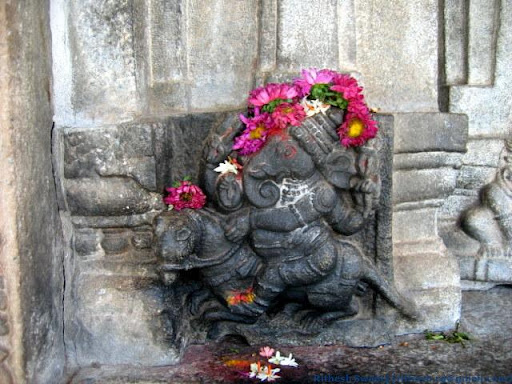
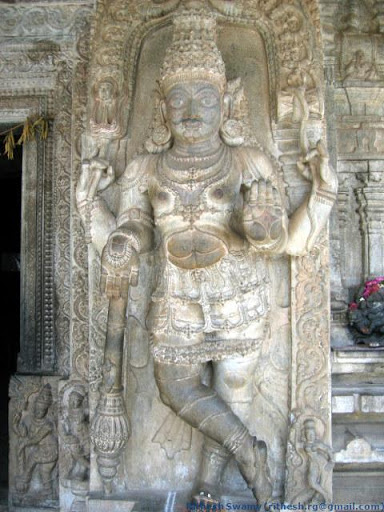
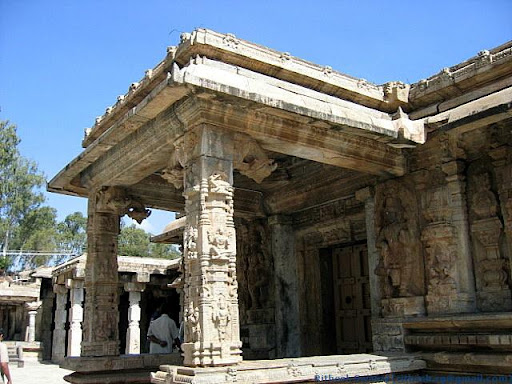


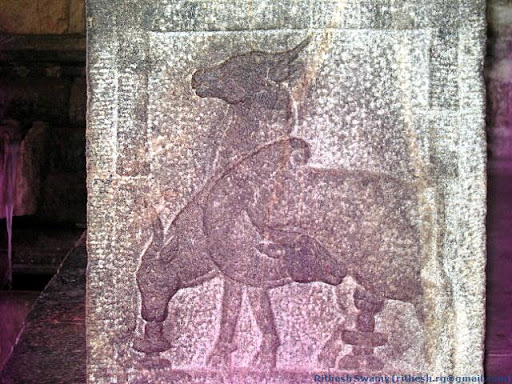
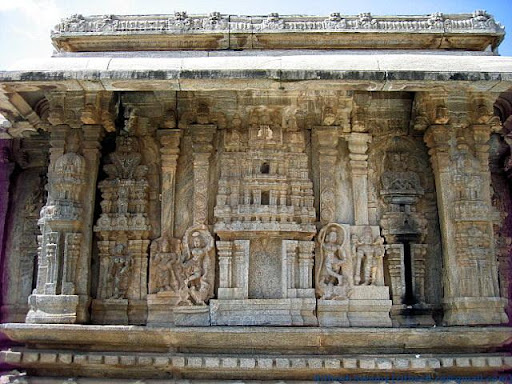
But so far as the temple itself is concerned there is no indication of such great antiquity. Its sculptures do not show the beauty, characteristic of the sculptures of the Chola and Hoysala periods. The wall images are generally too short for their height and have wide nostrils, projecting lips, large expressionless eyes, flat hands and conical kiritas and an attempted show of the folds of dhotis. The smaller reliefs contain seated lions, mixed beasts (gryphons”), etc., which were more common after the 14th century than before it. The stone used is also more coarsely grained than that usually selected by Chola sculptors. Here and there on the walls appear quadrangular based kalasas which are a common feature of late Hoysala and of Vijayanagar architecture. The surmise is that the building cannot be definitely assigned to any date before the middle of the 13th century. A bit of confounding evidence is obtained from the image of Sarasvati on the outer wall situated just to the east of the southern doorway. In her hand is held the representation of a book on which are written four characters in kannada reading Sa ra sva ti. The characters are more or less like those appearing in the 14th century inscriptions. Assuming that it was inscribed by the sculptor himself, we are led to infer that the temple belongs to the late Hoysala or early Vijayanagar period. Such a conclusion is opposed to the view held till now that the temple is of the Chola period. The tower is made up of flat late Vijayanagar bricks and is in a style similar to that found in the temples of the 15th and 16th centuries. On the whole, judging from these circumstances, even the date 1550 would not be very late for this tower. But Mr. R. Narasimhachar has noted the great similarity between the pillars of the southern porch and those of the Somesvara temple at Kurudumale where the latter belongs to the period of Ilavanji Vasudeva Raya, a Chola Viceroy under the Ballalas in the latter part of the 13th century. The sculptures of the Vaidyesvara temple are definitely inferior to those of the Vidyasankara temple of Sringeri, which was constructed during the life-time of Madhavamantri.
But the view that the building is of the Vijayanagar period and not of Chola increases our interest in it since it can be counted as one of the finest half a dozen temples produced during the Vijayanagar epoch. It can be classed with the Vithalasvami and Hazara Ramasvami temples of Hampi and the temples of Lepakshi and Tadpatri.
Most of the structures in the courtyard, however, belong to a later age. The main temple is probably earlier than the new Panchalinga shrines by a century or more.
On the north-east corner of the outer wall of the temple there is a four line Nagari inscription which mentions a certain Madhava. It is very probable that the last word is the name of the Hoysala officer Madhava, son of Perumale Danayaka, or of the famous early Vijayanagar officer Madhavamantri, who was a native of Talakad and possibly got the present temple erected over the old linga which was installed in the Chola times. It is a well known fact that Madhavamantri constructed the neighbouring dam known as the Madhavamantri anecut.
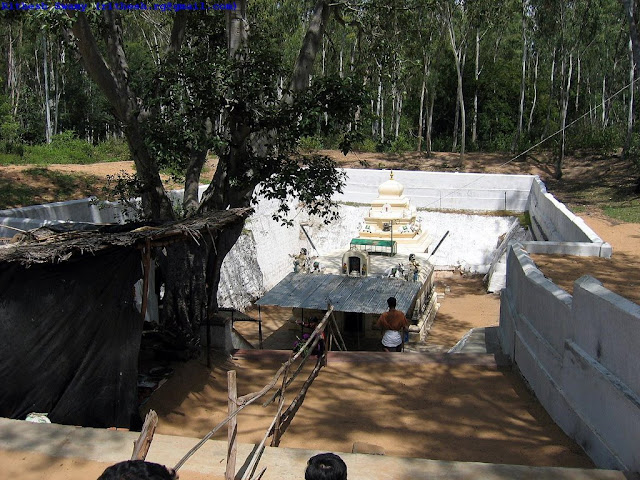
About a hundred yards to the south of the Kirtinarayana temple can be seen, in an excavated pit, the temple of Patalesvara. The building is comparatively small though it is one of the five pancha-linga temples. Its brick tower and the brick Nandis on its roof are, of course, recent. But the rest of the building which is of stone belongs to the 10th century and its outer walls bear three Gantha –Tamil inscriptions and one Kannada Hoysala inscription. The four pillars of the navaranga are of granite and have the round Chalukyan shape. A basement cornice running round the temple outside is also round .In the navaranga are kept a number of images of various dates, among which are
(1) A standing Brahma, with three faces visible and the hands holding : abhaya , rosary, kalasa and katihasta . The kirita indicates that it might be a very old piece
(2) Venkatesa;
(3) Dakshinamurti;
(4) Siva as Bhikshatana –murti;
(5) Mahishasuramardini standing in samabhanga with a buffalo head on the pedestal.
The linga in the garbhagriha is small and reddish in hue. It is said to change its colour into red in the morning , dark in the afternoon and white in the evening.

About a hundred yards to the west north –west of the Kirtinarayana temple is the temple of Maralesvara which, in many respects, resembles that of Patalesvara including its size. The round pillars in its navaranga and the rounded cornice on the outside of its basement support the evidence of the tamil inscription on its outer wall at the south –west corner and declares it as a monument of the chola. or early (Hoysala) period.
The basement of the garbhagriha is ornamented with cornices having small arches and the navaranga has in addition to the two fine round pillars eight- sided and sixteen-sided fluted pillars. The sukhanasi which was probably open originally, as in the Patalesvara temple, has been provided with a door –frame of recent times . In the navaranga are kept several images:
Mahishasuramardini standing (abhaya, chakra, sankha, and katihasta)—with a buffalo-head on the pedestal(Ganga or Chola period).
Kumarasvami standing with a peacock behind.
Ganesa.
Madhava standing ,about 5 feet high with gada, prayoga –chakra,and sankha and the left front hand in katihasta, instead of holding padma. The image is beautiful and could be assigned to an early period but its thin body ,stout arms and conventionalized dhoti in combination with its ornate kirita suggest it belongs to the 14th century.
Brahma.
Surya standing –with two arms, Aruna and seven horses on the pedestal the chhayas standing at rest and eight of the Adityas on the torana the (eight vasus?). The garbhagriha has a large linga, whose very rough surface suggests a natural shape . Its pitha is about 5 feet square and the two together might be attributed to a very early date. (compare with Pranavesvara of Talgunda.)

5 kms to the east of Talakad and half a km from the village Bijapura and close to the road near the ancient fort at manne(village) is the Arkeshwara Temple which is one of the panchalingas .The original temple was of the period of the Gangas ,but it has been constructed by using the materials of the original temple .The temple has a garbhagriha,sukhanasi and a navaranga and houses the Arkeshwara linga of about 15 inches in diameter .Sukhanasi has a small image of nandi. Navaranga has eight sided ordinary pillars .In front of the temple are four modern rooms in a row which contain four lingas .In between the main temple and the four rooms is a small shrine for surya which has been built by slabs containing different inscriptions. Near the shrine of Surya are found two blackstone pillars of bell type of which one is half beside in the ground and perhaps they might have been used in building the original temple. The monolithic image of Surya is of the Ganga period and about three fourth mt in height is in low relief and has a prabhavali .According to tradition the first rays of the sun falls on the Arkeshwara linga on the Rathasaptami day.
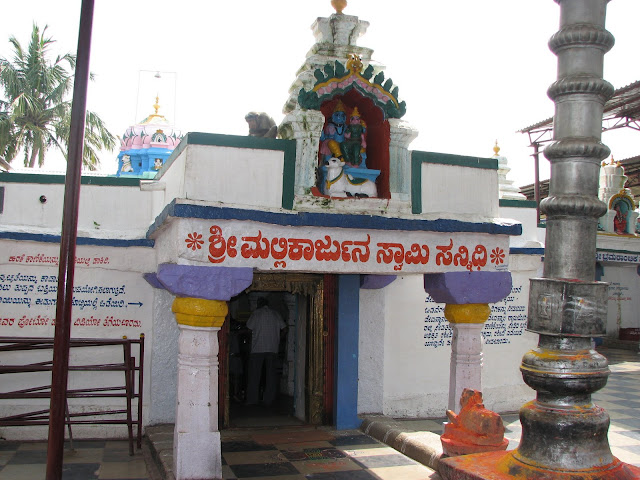
This temple is situated on the mudukuthore hill which is 5 kms to the north of Talakad .originally a temple of the Gangas it has been reconstructed in the Vijayanagara style. The mahatwara(the main gateway facing the west and the gopura on it are believed to have been built by Krishnaraja Wadeyar ΙΙΙ over the Mahadwara on both sides of the gopura are found brick and mortar sculptures of two big nandis . Near the Mahadwara is a stone lamp post of about 40 ft in height . The height of the hillock is about 250 ft and it has flight of steps and also a motorable road to reach the top.


The temple on the hillock consist of a garbhagriha, ardhamantapa , antarala , navaranga and Dwaramantapa .Near the Dwaramantapa is a dhwahastambha coverd with brass plates and below it is a balipitha. In the garbhagriha is a small Mallikarjuna linga of five inches on a panivatta of a square foot. It is believed that this is self manifested (svayam udbhava). On the linga is in the foot mark of Kamadhenu. In the Navaranga are found the Sculptures of Vighnesvara, Subramanyesvara and recently consecrated two Sivalingas. In the shrine to the north of the Navaranga is a processional image (utsava murthi) of Malikarjunesvara and sculptures of karthikeyan , nataraja, Ganapati and Sivakameshvari. Navaranga has circular and dwarfish pillars . On them are found low relief sculptures of Rama , Lakshmana, Hanumantha , dancers etc.
In the north-western corner of the enclose of the temple (parakara0 is a painting mantapa built during the third quarter of the 19th century A.D. Its walls have painting depicting sacrifice (yaga) by parameshvara, the seven sages (Saptarshis) sequesting parvathi for a boon , and incidents dikpalakas, Girijakalyana etc as described in the Siva purana and Devibhagavata, Apsaras, Kamadhenu, Kolata etc. In the north of the prakara is the hall of sacrifice(yagashala) and at the north-east are temples of Ganapathi and Navagrahas . At the backside are five seprate lingas and shrines for Durgi, Vrishabhesvara and Kashi Vishweshwara. Near the mantapa the southern entrance is found the scared feet of Madeshvara. On the backside wall of the garbhagriha is a beautiful low relief sculpture of goddess Durgi . To the left of the main shrine is a temple for goddness Bhramaramba. This has a garbhagriha, ardhamantapa, navaranga, mukhamantapa and a Vimana gopura .The image of standing goddness is very elegant. The processional image of Bhramaramba is worshipped daily in the Vaidyeshvara temple and is taken to the mudukuthore temple on the special occasion of the fair (Jatre) and Chariot procession.
On getting down through the steps are found a small shrine for kalabhairava and a mantapa to the south .At the foot of the hill to the left is a shrine for Basavesvara and in the ground where annual fair taken place are found some small mantapas and watersheds (place where drinking water is given as a service)
How to Reach Talakadu Route:
1. From Bangalore take the kanakapura road to go to Kanakapura - around 50 km
2. Continue further to Malavalli - around 40 km.
3. From Malavalli take the road towards Kollegal.
4. After 10-15 km take a deviation to right towards talakadu.
5. Destination can be reached in about 20 km
Distance: 130 km from Bangalore
For More Information Visit : panchalingadarshana.com
During the period of darshan, pilgrims take a holy dip in the Cauvery River (Kaveri) and worship the main deity at Vaidyeshwara temple followed by Arakeshwara, Maraleswara, Pathaleswara and Mallikarjuna temples. All the temples are located in a radius of five miles.
The Vaideshwara Temple, which is the epicenter of Panchalinga Darshan, is completely buried beneath sand dunes during certain period depending on the water level in Kaveri River. The temple comes to life when it is excavated for the Panchalinga Darshan.
Vaidyeshwara, Pataleshwara, Maruleshwara are located at Talakad, Arkeshwara is located at Vijapura, and Mallikarjuna is at Mudukuthore.
Panchalinga darshana is a rare pilgrimage occasion, occuring once in every few years. Tradition has it that pilgrims should first bath in the Gokarna theertham, worship Gokarneswara and Chandikadevi, and then worship Vaidyeshwara, and then bath in the northern eastern southern and western stretches of the Kaveri and then worship Arkeshwara, Pataleshwara, Maraleshwara and Mallikarjuna, returning to Vaidyeshwara after each worship, finally worship Kirtinarayana and conclude the pilgrimage in one day.
Mythology
The highly religious atmosphere has given rise to mythological connections of Talakad. As narrated in skanda purana, the place got its name from the two kiratas by name Tala and Kada. Somadatta a pious brahmana of kasi prayed to lord Sive for moksha and he was asked to proceed to Talakad or Gajaranyakshetra.
On his way he and his associates were killed and they were reborn as elephants at Siddhogajaranyakshetra. These elephants after their daily bath used to worship a tree with flower and the two kirata brothers Tala and Kada out of curiosity cut this tree only to be astonished to see a Sive linga. They prayed to Lord Sive for mercy and attained Maksha and henceforth the place came to be known as Talakada. Because of the divine elephants the place became sacred as Siddha gajaranyakshetra.
It is not easy to explain the place name Talakadu in a satisfactory manner.
Though it is not possible to understand the meaning of the first part namely Tala,the second part kadu in Kannada means a forest. Hence it was Sanskritised
as Talavanapura or Dalavanapura (Tala+vana+pura). Epigraphs of the early period refer to this place by its Sanskritised form Talavanapura.
Before understanding the history of the place it is desirable to refer to an important religious event with which this place is associated and is also famous for it. This is Panchalinga darsana and lakhs of people throng at this place to have the darsana of five lingas on a day on which strange astronomical combination takes place. This combination is as follows: It should be a new moonday of the month of Kartida and a Monday and the Sun should be in scorpio. This combination occurs at various intervals ranging from four to fourteen years. The last Panchalinga darjana took place on 16-11-2009.
Siva manigested himself in different parts of this place. They are Arkesvara on the bank of uttaravahini:Patalesvara or Vasukisvara on the bank of Purvavahini;
Maralesvaran or Saikatevara on the dakshinavahini Mallikarjunesvara on the Somagiri or Mudukutore on the paschimavahini and Vaidyesvara in the centre. The ritual of Panchalinga darsana involves first taking both in Gokarnatirtha and visiting Vaidyesvara in wet clothes. Then the other four lingas should be worshipped, each time taking fresh bath and reporting it Vaidyesvara each time in the order of Arkesvara, Patalesvara, Maralesvara and Mallikarjunesvara. The entire round by walk covers a distance of about 30 Kms and this has to be finished in one day. The religious fervor of the devotees is such that literally several lakhs of people meticulously follow the above routine and complete the ritual of Panchalinga darsana and earn religious merit.
History : Curse of Srirangamma also referred to as Alamelamma
Talakad becomes a part of the Vijaynagara empire. madhava-mantri who belonged to Talakad itself built an anecut in C. 1342 A.D. which helped the irrigation of nearby lands and became a great boon to the people of Talakad.
Realising the significance of Talakad, the Vijayanagara rulers made it into an important town. The local governor who was stationed at Srirangapattana Was to look after Talakad. Actually Tirumalaraya, also calledSrirangaraya, was the governor,at Srirangapattana in the early part of the seventeenth century. At this point we have to reconstruct the history of Talakad with the help of literary works and a popular folk tale.
Srirangaraya, the governor at Srirangapattana was afflicted with some deadly disease and on hearing the healing powers of God Vaidyesvara at Talakad came to the temple. His wife Srirangamma also referred to as Alamelamma, was kept in charge at Srirangapattana. But the condition of Srirangaraya deteriorated and irangamma came to Talakad to see her husband. The ruling Mysore Wadeyar king Raja Wadeyar came to dnow of this. He also heard of the large amount of precious jewellery brought by Srirangamma. Of them a fine nose ornament caught the fancy of Raja Wadeyar and requested Srirangamma to five it to him.
When the lady refused to part with it, Raja Wadeyar declared a war and reached the other bank at malingi .She crossed over the river and reached the other bank at malingi .Sshe threw all the jewels into folk curse thus:
Talakadu maralagali
Malingi maduvagali
Mysurudoregalige makkalilllade hogali
It means:Let Talakad become sand ; Malingi become a whirlpool and let there be no children to the kings of Mysore . This folk tala thus explains the formation of the sand dunes at Talakad. The date of this event is said to have been 1610 A.D. The significance of this event will be discussed later. Thus, Talakad came to be included in Wadeyar kingdom and it remained with the Wadeyars till the erstwhile Mysore state became a part of the Indian union under the name Karnataka state.
According to this traditional story, formation of sand dunes began to take place in the early part of the seventeenth century A.D. As the river Kaveri takes a sharp bend here during the period of south-west monsoon, particles of sand are carried by the wind with great speed and deposited on the part of the town.
Thus the sand used to advance at the rate of 8 to 10 feet per year. In course of time, the entire town was covered with sand to a height of thirty feet. As and when the sand began to advance, inhabitants lift the village and moved towards north. Thus the ancient town around Kirtinarayana ,Patalesvara, Maralesvara,and Vaidyesvara temles have been covered by the sands. This was the old town during the pre-Vijayanagara period. It seems that during the period of Sir.M.Visweswaraiah, trees were planted in good numbers to prevent the carrying of sands into the town. Perhaps, this was partly successful and the sands have not advanced further. Thus, sand has played an important role in the liter history of Talakad.
Panchalinga Temples:
Vaidyeshsara TempleArkeshwara Temple
Vasukishwara or Pataleshwara Temple
Saikateshwara or Maraleshwara Temple and
Mallikarjuna Temple
Vidyeshwara Temple:
About 150 yards to the east of the Kirtinarayana temple stands the temple of Vaidyesvara almost at the south-western end of what remains of old Talkad, and close to the sand dunes. It is the most elaborately carved temple in the whole neighbourhood. It is constructed almost entirely of close-grained granite similar to the material used for the Kirtinarayana temple; and for a granite structure, the elaborate carvings are surprisingly good.
The origin of the temple, however, is enshrouded in mystery. A number of fragmentary Hoysala inscriptions have been found built into the basement of the mahadvara but the fragmentary nature of nearly every one of them and their complete silence about the construction of the temple show that they were collected and used for constructional work at a later age. A stone inscription above one of the lintels of the new Panchalingesvara temple belongs to A.D. 1633 and refers to God Vaidyesvara of Gajaranyakshetra. Several of the Chola and Hoysala inscriptions mention that the god Rajarajesvara was possibly set up for the merit of Raja Raja Chola. It may be identical with the Vaidyesvara linga. The name Vaidyesvara is suggestive of Tamilian connections.






But so far as the temple itself is concerned there is no indication of such great antiquity. Its sculptures do not show the beauty, characteristic of the sculptures of the Chola and Hoysala periods. The wall images are generally too short for their height and have wide nostrils, projecting lips, large expressionless eyes, flat hands and conical kiritas and an attempted show of the folds of dhotis. The smaller reliefs contain seated lions, mixed beasts (gryphons”), etc., which were more common after the 14th century than before it. The stone used is also more coarsely grained than that usually selected by Chola sculptors. Here and there on the walls appear quadrangular based kalasas which are a common feature of late Hoysala and of Vijayanagar architecture. The surmise is that the building cannot be definitely assigned to any date before the middle of the 13th century. A bit of confounding evidence is obtained from the image of Sarasvati on the outer wall situated just to the east of the southern doorway. In her hand is held the representation of a book on which are written four characters in kannada reading Sa ra sva ti. The characters are more or less like those appearing in the 14th century inscriptions. Assuming that it was inscribed by the sculptor himself, we are led to infer that the temple belongs to the late Hoysala or early Vijayanagar period. Such a conclusion is opposed to the view held till now that the temple is of the Chola period. The tower is made up of flat late Vijayanagar bricks and is in a style similar to that found in the temples of the 15th and 16th centuries. On the whole, judging from these circumstances, even the date 1550 would not be very late for this tower. But Mr. R. Narasimhachar has noted the great similarity between the pillars of the southern porch and those of the Somesvara temple at Kurudumale where the latter belongs to the period of Ilavanji Vasudeva Raya, a Chola Viceroy under the Ballalas in the latter part of the 13th century. The sculptures of the Vaidyesvara temple are definitely inferior to those of the Vidyasankara temple of Sringeri, which was constructed during the life-time of Madhavamantri.
But the view that the building is of the Vijayanagar period and not of Chola increases our interest in it since it can be counted as one of the finest half a dozen temples produced during the Vijayanagar epoch. It can be classed with the Vithalasvami and Hazara Ramasvami temples of Hampi and the temples of Lepakshi and Tadpatri.
Most of the structures in the courtyard, however, belong to a later age. The main temple is probably earlier than the new Panchalinga shrines by a century or more.
On the north-east corner of the outer wall of the temple there is a four line Nagari inscription which mentions a certain Madhava. It is very probable that the last word is the name of the Hoysala officer Madhava, son of Perumale Danayaka, or of the famous early Vijayanagar officer Madhavamantri, who was a native of Talakad and possibly got the present temple erected over the old linga which was installed in the Chola times. It is a well known fact that Madhavamantri constructed the neighbouring dam known as the Madhavamantri anecut.
Pathaleshwara Temple:

About a hundred yards to the south of the Kirtinarayana temple can be seen, in an excavated pit, the temple of Patalesvara. The building is comparatively small though it is one of the five pancha-linga temples. Its brick tower and the brick Nandis on its roof are, of course, recent. But the rest of the building which is of stone belongs to the 10th century and its outer walls bear three Gantha –Tamil inscriptions and one Kannada Hoysala inscription. The four pillars of the navaranga are of granite and have the round Chalukyan shape. A basement cornice running round the temple outside is also round .In the navaranga are kept a number of images of various dates, among which are
(1) A standing Brahma, with three faces visible and the hands holding : abhaya , rosary, kalasa and katihasta . The kirita indicates that it might be a very old piece
(2) Venkatesa;
(3) Dakshinamurti;
(4) Siva as Bhikshatana –murti;
(5) Mahishasuramardini standing in samabhanga with a buffalo head on the pedestal.
The linga in the garbhagriha is small and reddish in hue. It is said to change its colour into red in the morning , dark in the afternoon and white in the evening.
Maraleshwara Temple:
About a hundred yards to the west north –west of the Kirtinarayana temple is the temple of Maralesvara which, in many respects, resembles that of Patalesvara including its size. The round pillars in its navaranga and the rounded cornice on the outside of its basement support the evidence of the tamil inscription on its outer wall at the south –west corner and declares it as a monument of the chola. or early (Hoysala) period.
The basement of the garbhagriha is ornamented with cornices having small arches and the navaranga has in addition to the two fine round pillars eight- sided and sixteen-sided fluted pillars. The sukhanasi which was probably open originally, as in the Patalesvara temple, has been provided with a door –frame of recent times . In the navaranga are kept several images:
Mahishasuramardini standing (abhaya, chakra, sankha, and katihasta)—with a buffalo-head on the pedestal(Ganga or Chola period).
Kumarasvami standing with a peacock behind.
Ganesa.
Madhava standing ,about 5 feet high with gada, prayoga –chakra,and sankha and the left front hand in katihasta, instead of holding padma. The image is beautiful and could be assigned to an early period but its thin body ,stout arms and conventionalized dhoti in combination with its ornate kirita suggest it belongs to the 14th century.
Brahma.
Surya standing –with two arms, Aruna and seven horses on the pedestal the chhayas standing at rest and eight of the Adityas on the torana the (eight vasus?). The garbhagriha has a large linga, whose very rough surface suggests a natural shape . Its pitha is about 5 feet square and the two together might be attributed to a very early date. (compare with Pranavesvara of Talgunda.)
Arkeshwara Temple:
5 kms to the east of Talakad and half a km from the village Bijapura and close to the road near the ancient fort at manne(village) is the Arkeshwara Temple which is one of the panchalingas .The original temple was of the period of the Gangas ,but it has been constructed by using the materials of the original temple .The temple has a garbhagriha,sukhanasi and a navaranga and houses the Arkeshwara linga of about 15 inches in diameter .Sukhanasi has a small image of nandi. Navaranga has eight sided ordinary pillars .In front of the temple are four modern rooms in a row which contain four lingas .In between the main temple and the four rooms is a small shrine for surya which has been built by slabs containing different inscriptions. Near the shrine of Surya are found two blackstone pillars of bell type of which one is half beside in the ground and perhaps they might have been used in building the original temple. The monolithic image of Surya is of the Ganga period and about three fourth mt in height is in low relief and has a prabhavali .According to tradition the first rays of the sun falls on the Arkeshwara linga on the Rathasaptami day.
Mallikarjuan Swamy Temple:
This temple is situated on the mudukuthore hill which is 5 kms to the north of Talakad .originally a temple of the Gangas it has been reconstructed in the Vijayanagara style. The mahatwara(the main gateway facing the west and the gopura on it are believed to have been built by Krishnaraja Wadeyar ΙΙΙ over the Mahadwara on both sides of the gopura are found brick and mortar sculptures of two big nandis . Near the Mahadwara is a stone lamp post of about 40 ft in height . The height of the hillock is about 250 ft and it has flight of steps and also a motorable road to reach the top.
The temple on the hillock consist of a garbhagriha, ardhamantapa , antarala , navaranga and Dwaramantapa .Near the Dwaramantapa is a dhwahastambha coverd with brass plates and below it is a balipitha. In the garbhagriha is a small Mallikarjuna linga of five inches on a panivatta of a square foot. It is believed that this is self manifested (svayam udbhava). On the linga is in the foot mark of Kamadhenu. In the Navaranga are found the Sculptures of Vighnesvara, Subramanyesvara and recently consecrated two Sivalingas. In the shrine to the north of the Navaranga is a processional image (utsava murthi) of Malikarjunesvara and sculptures of karthikeyan , nataraja, Ganapati and Sivakameshvari. Navaranga has circular and dwarfish pillars . On them are found low relief sculptures of Rama , Lakshmana, Hanumantha , dancers etc.
In the north-western corner of the enclose of the temple (parakara0 is a painting mantapa built during the third quarter of the 19th century A.D. Its walls have painting depicting sacrifice (yaga) by parameshvara, the seven sages (Saptarshis) sequesting parvathi for a boon , and incidents dikpalakas, Girijakalyana etc as described in the Siva purana and Devibhagavata, Apsaras, Kamadhenu, Kolata etc. In the north of the prakara is the hall of sacrifice(yagashala) and at the north-east are temples of Ganapathi and Navagrahas . At the backside are five seprate lingas and shrines for Durgi, Vrishabhesvara and Kashi Vishweshwara. Near the mantapa the southern entrance is found the scared feet of Madeshvara. On the backside wall of the garbhagriha is a beautiful low relief sculpture of goddess Durgi . To the left of the main shrine is a temple for goddness Bhramaramba. This has a garbhagriha, ardhamantapa, navaranga, mukhamantapa and a Vimana gopura .The image of standing goddness is very elegant. The processional image of Bhramaramba is worshipped daily in the Vaidyeshvara temple and is taken to the mudukuthore temple on the special occasion of the fair (Jatre) and Chariot procession.
On getting down through the steps are found a small shrine for kalabhairava and a mantapa to the south .At the foot of the hill to the left is a shrine for Basavesvara and in the ground where annual fair taken place are found some small mantapas and watersheds (place where drinking water is given as a service)
How to Reach Talakadu Route:
1. From Bangalore take the kanakapura road to go to Kanakapura - around 50 km
2. Continue further to Malavalli - around 40 km.
3. From Malavalli take the road towards Kollegal.
4. After 10-15 km take a deviation to right towards talakadu.
5. Destination can be reached in about 20 km
Distance: 130 km from Bangalore
For More Information Visit : panchalingadarshana.com


Nice snaps :)
ReplyDeletewe visited Talkadu a few months back..
21 people , 11 bikes , 1/3rd of our class :D
Let freedom ride \m/
http://prabhukarthik03.wordpress.com/2010/11/07/22talakadu-221010/
http://theloapers.blogspot.com/2010/11/22talkad-221010.html